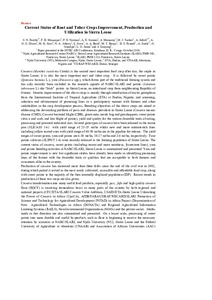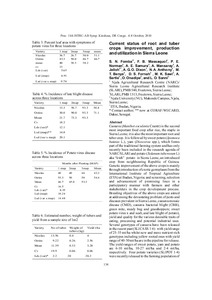| dc.contributor.author | Fomba, S.N. |
| dc.contributor.author | Massaquoi, F.B. |
| dc.contributor.author | Norman, P.E. |
| dc.contributor.author | Samura, A.E. |
| dc.contributor.author | Mansaray, A. |
| dc.contributor.author | Jalloh, A. |
| dc.contributor.author | Dixon, Alfred G.O. |
| dc.contributor.author | Anthony, N.A. |
| dc.contributor.author | Benya, M.T. |
| dc.contributor.author | Fornah, D.S. |
| dc.contributor.author | Sawi, M.K. |
| dc.contributor.author | Sartie, A.M. |
| dc.contributor.author | Onadipe, O. |
| dc.contributor.author | Sanni, L.O. |
| dc.date.accessioned | 2019-12-04T11:07:57Z |
| dc.date.available | 2019-12-04T11:07:57Z |
| dc.date.issued | 2012-02 |
| dc.identifier.citation | Fomba, S.N., Massaquoi, F.B., Norman, P.E., Samaru, A.E., Mansaray, A., Jalloh, A. ....& Sanni, L.O. (2012). Current status of root and tuber crops improvement, production and utilization in Sierra Leone. In: Proceedings of the 11th triennial Symposium of the International Association of Hydrological Sciences held at Memling Hotel: Tropical roots and tuber crops and the challenges of globalization and climate changes, (pp. 134-150), Kinshasa, 4-8 October, Ibadan: ISTRC-AB. |
| dc.identifier.uri | https://hdl.handle.net/20.500.12478/1662 |
| dc.description.abstract | Cassava (Manihot esculenta Crantz) is the second most important food crop after rice, the staple in Sierra Leone; it is also the most important root and tuber crop. It is followed by sweet potato (Ipomoea batatas L.), yam (Dioscorea spp.), which forms
part of the traditional farming system and has only recently been included in the research agenda of NARC/SLARI and potato (Solanum tuberosum L) aka “Irish” potato in Sierra Leone, an introduced crop from neighbouring Republic of Guinea. Genetic improvement of the above crops is mainly through introduction of exotic germplasm from the International Institute of Tropical Agriculture (IITA) at Ibadan, Nigeria; and screening, selection and advancement of promising lines in a participatory manner with farmers and other stakeholders in the crop development process. Breeding objectives of the above crops are aimed at addressing the devastating problem of pests and diseases prevalent in Sierra Leone, cassava mosaic disease (CMD), cassava bacterial blight (CBB), green mite, mealy bug and grasshoppers; sweet potato virus x and scab, and late blight of potato), yield and quality for the various desirable traits of eating, processing and potential industrial uses. Several genotypes of cassava have been released in the recent past (SLICASS 1-6) with yield range of 25-35 mt/ha whilst new and more nutrient-rich
genotypes including yellow rooted ones with yield range of 40-50 mt/ha are in the pipeline for release. The yield ranges of sweet potato, yam and potato are 6-10 mt/ha, 10-27 mt/ha and 2-4 mt/ha, respectively. Four potato varieties (SLIPOT 1-4)
were recently released to the farming population of Sierra Leone. The current status of cassava, sweet potato (including recent and more nutritious, âcarotene genotypes), yam and potato breeding activities at NARC/SLARI, Sierra Leone is summarized and presented. Yam and potato improvement is new but significant strides have already been made in identifying promising lines of the former with the desirable traits or qualities that are acceptable to both farmers and consumers alike in the country.
Production of cassava has increased more than three folds since the end of the civil war in 2002, during which period it served as the most easily cultivated, accessible and affordable food crop, along with sweet potato to the majority of the then internally displaced population (IDP). Recent trends in production of these two crops are also given. Cassava transformation into many useful food products, especially gari, fufu and high quality cassava flour (HQCF) is receiving tremendous boost in many parts of the country by both regional and national projects (CFC/IITA/SLARI) Cassava Value Addition, USAID/IITA-Sierra Leone
Unleashing the Power of Cassava in Africa (UpoCA), AfDB/FARA/CORAF/WECARD/ SLARI Promotion of Science and Technology for Agricultural Development (PSTAD) in Africa Project (Dissemination of New Agricultural Technologies in Africa (DONATA) and Regional Agricultural Information Learning Systems (RAILS), Non-Governmental Organizations (NGOs) and the private sector. Strides made in that direction are also summarized and presented. On a lesser scale, processing of sweet potato into more durable and useful by-products such as flour is beginning to receive the necessary attention by scientists at NARC/SLARI, and Njala University (NU), Sierra Leone and the Federal University of Agriculture at Abeokuta (UNAAB) and
Association of African Universities (AAU) Regional Food Developers Initiative (FDI) Project, Nigeria. This will hopefully prevent market glut and improve the livelihood of root and tuber crops farmers with a consequent reduction in poverty. |
| dc.format.extent | 134-150 |
| dc.language.iso | en |
| dc.publisher | International Association of Hydrological Sciences |
| dc.subject | Manihot Esculenta |
| dc.subject | Cassava |
| dc.subject | Ipomoea Batatas |
| dc.subject | Solanum Tuberosum |
| dc.subject | Sierra Leone |
| dc.subject | Dioscorea Spp |
| dc.subject | Sweet Potato |
| dc.subject | Yams |
| dc.subject | Genotypes |
| dc.title | Current status of root and tuber crops improvement, production and utilization in Sierra Leone |
| dc.type | Conference Proceedings |
| cg.contributor.crp | Roots, Tubers and Bananas |
| cg.contributor.affiliation | Njala Agricultural Research Centre |
| cg.contributor.affiliation | Sierra Leone Agricultural Research Institute |
| cg.contributor.affiliation | Njala University |
| cg.contributor.affiliation | International Institute of Tropical Agriculture |
| cg.coverage.region | Africa |
| cg.coverage.region | West Africa |
| cg.coverage.country | Sierra Leone |
| cg.authorship.types | CGIAR and developing country institute |
| cg.iitasubject | Cassava |
| cg.iitasubject | Disease Control |
| cg.iitasubject | Genetic Improvement |
| cg.iitasubject | Pests Of Plants |
| cg.iitasubject | Plant Diseases |
| cg.iitasubject | Plant Genetic Resources |
| cg.iitasubject | Yam |
| cg.howpublished | Formally Published |
| cg.publicationplace | Ibadan, Nigeria |
| cg.accessibilitystatus | Limited Access |
| local.dspaceid | 82816 |
| cg.targetaudience | Scientists |


